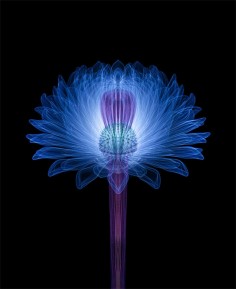MACOTO MURAYAMA
村山诚泰
inorganic flora
source: frantic
Macoto Murayama cultivates inorganic flora. First, he chooses the plant and finds the real flower, for example the exquisite Lathyrus odoratus L. Second, he dissects the flower cutting the petal and ovary with scalpel and observes it with magnifying glass. Third, he makes sketches and photographs the parts of dissected flower. Forth, he models its form and structure using 3ds Max (3DCG software). Fifth, he renders separate parts and creates a composition using Adobe Photoshop. Sixth, he imposes admeasurements, parts names, scale, scientific name etc. Seventh, he prints out Lathirus odoratus L. at large scale printer and frames it… Here it is, The Flower of Totalitarian Scientific Conscious: properly fixed, totally measured, strictly nominated and distinctly shown. It is not only an image of a plant, but representation of the intellect’s power and its elaborate tools for scrutinizing nature. The transparency of this work refers not only to the lucid petals of a flower, but to the ambitious, romantic and utopian struggle of science to see and present the world as transparent (completely seen, entirely grasped) object. Paradoxically, this scientific challenge to measure the Universe might eventually become one of the sources where art of Murayama draws its strength of fantasy and odor of romanticism, becoming a part of Botech Art, symbiosis of Botanical Art and Technology.
.
.
.
.
.
.
.
source: fineprintnyc
Macoto Murayama is a Japanese architect who has delved into art with this intricate series of floral blueprints. His process is quite fascinating. First he dissects a flower with scalpel and observes it with a magnifying glass. Next he makes sketches and photographs the parts of dissected flower. With the sketches complete, he begins modeling using 3ds Max (CGI software). He then renders separate parts and creates a composition using Adobe Photoshop. According to Murayama, the transparency of his work refers not only to the lucid petals of a flower, but to the ambitious, romantic and utopian struggle of science to see and present the world as transparent (completely seen, entirely grasped) object. His work was recently featured in a Panasonic spot. Be sure to check out that video after the jump.
.
.
.
.
.
.
.
source: artbulhot
Красивата серия Flora Inorganic е създадена от Японския художник Macoto Murayama ,след неговото обстойно изследване на фотографии и ботанически илюстрации.Тя предлага нова форма на представяне на растенията,нещо повече от това което сме свикнали да виждаме в ботаническите илюстрации.
.
.
.
.
.
.
.
source: florencerosello
Encore des fleurs! Digitales celles-ci, comme des radiographies, Macoto réalise de véritables études botaniques. Il dessine d’après les photos de végétaux qu’il a disséqués, puis passe à la 3D pour réaliser ces illustrations tout en finesse et en transparences.
.
.
.
.
.
.
.
source: franticjp
手塚村山は、無機植物を栽培。まず、彼は植物を選択し、本物の花を見つけ、例えば絶妙スイートピー属Odoratus L.第二に、彼はメスで花びらと卵巣をカット花を解剖し、虫眼鏡を使って観察する。第三に、彼がスケッチや写真解剖花の部分を作る。第四に、彼は3ds Maxのを( 3DCGソフトウェア)を使用して、その形態と構造をモデル化します。第五に、彼は独立した部品をレンダリングとAdobe Photoshopを使用し構成を作成します。第六に、彼はadmeasurements 、部品名、スケール、彼は大規模なプリンタやフレーム、それを時Lathirus属Odoratus L.を出力学名など七を課し…ここではそれは、花の全体主義科学意識:正しく、完全に固定されて測定され、厳密に指名され、はっきりと示す。それは自然を精査するための知性のパワーとその精巧なツールの植物のイメージが、表現だけではありません。この作業の透明性は、花の明快な花びらに、しかし透明に世界を見て提示する科学の野心的な、ロマンチックでユートピア闘争(完全に完全に把握し、見られるように)オブジェクトにのみならず、を指します。逆説的に、宇宙を測定するには、この科学的な課題は、結局Botechアート、ボタニカルアートとテクノロジーの共生の一部になって、村山の芸術は幻想とロマンの匂いのその強さを描く源の一つになるかもしれない。
.
.
.
.
.
.
.
source: designboom
riginally scheduled for last march but delayed by the earthquake in japan, tokyo’s frantic gallery
presents this december ‘inorganic flora’, the first solo exhibition of japanese new media artist macoto murayama, who layers the worlds of biological investigation, artistic design, and historical study in his collection of digital prints. the exhibition is divided into two primary parts, ‘botanical diagram’, the prints of flower images with textual and mathematical markings, and ‘botech art’, pieces which emphasis colour and depth. the botanical diagrams are modeled after historical reference works and engineering plans, utilizing similar conventions of labeling and layout, but nonetheless treating the subject with an aesthetically minded eye in the tradition of historical botany illustrations.
the creation of each design is a multistep and multimedia process. murayama begins with research and dissection of botanical specimens, photographing and sketching their parts. he then composes a 3D model in 3DS max, modifying individual elements in photoshop and matting the completed diagram in illustrator with captions and indication of scale.many of the works feature multiple perspectives of a single specimen, as in ‘commelina communis’ and ‘lathyrus odoratus’, where conventional top, front, and side view diagrams are joined by the multi-organism ‘ecology’ composition. among the ‘botech’ pieces, murayama experiments with diverse colours and arrangements of singular species, often creating as many as five or more different renditions of the same plant.
.
.
.
.
.
.
.
.
source: franticjp
New media artist Macoto Murayama, who uses cut-edge software and 3D modeling to create Botanical Illustrations of the 21st century. We would like to use this opportunity to explain to the audience 1. the process of the creation of Murayama’s Flowers (from research of existing flora to digital technologies artist applies), 2. the context of his work in historical perspective and in connection with both technical art and botanical art (from early botanical illustration in Ancient Greece to the X-Ray Art of late 20th century), 3. hierarchy of Murayama’s digital drawings and indication he uses for his vast body of works (relationship between “Inorganic Flora”, “Botanical Diagram” and “Botech Art” terms as well as indexes he uses for the work titles such as “w”, “b”, “wc”, “bc”). Numerous art works are going to be exhibited including three “Botanical Diagrams”, Botanical Matrix composed of more than 30 Botech Art works and the latest two meters work diagram in color. We hope “Inorganic Flora” Exhibition will reveal intricate connections between visual art and science, provoking frantic conversations about ancient tradition of depicting flowers and its possible future in Digital Age.
.
.
.
.
.
.
.
source: franticjp
必死のギャラリーは、21世紀の植物イラストを作成するために、カットエッジソフトウェアと3Dモデリングを使用する新しいメディア·アーティスト手塚村山、最初の個展を提示して嬉しいです。私たちは、観客1に説明するために、この機会を利用したいと思います。村山の花の作成プロセス(デジタル技術のアーティストへの既存の植物相の調査から適用されます) 、 2 。歴史的な観点および技術的芸術とボタニカルアートの両方に関連して、彼の作品の文脈( 20世紀後半のX線アートに古代ギリシャの早い植物の実例から) 、 3 。村山のデジタル図面や表示の階層は、彼が作品の彼の広大なボディ(彼はそのような”W”としての仕事のタイトルに使用する”無機フローラ”、 “植物図”と ” Botechアート”という用語だけでなく、インデックスとの間の関係、 “に使用b “は、 “トイレ”、” BC ” ) 。数多くの芸術作品は30以上Botechアート作品や色の最新2メートル作業ダイアグラムからなる3 “植物図” 、植物マトリックスを含む展示しようとしている。私たちは、 “無機フローラ”展花とデジタル時代で、その将来を描いた古代の伝統についての必死の会話を刺激、視覚芸術と科学の間の複雑な接続を明らかにすることを願っています。


